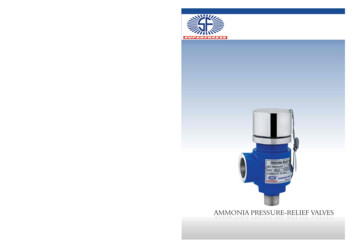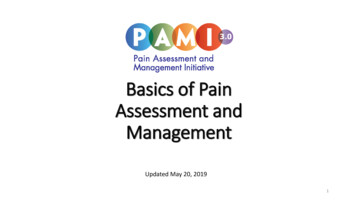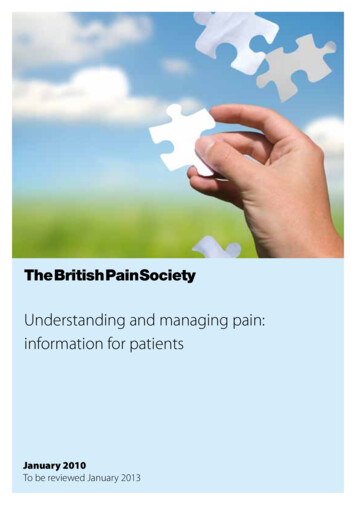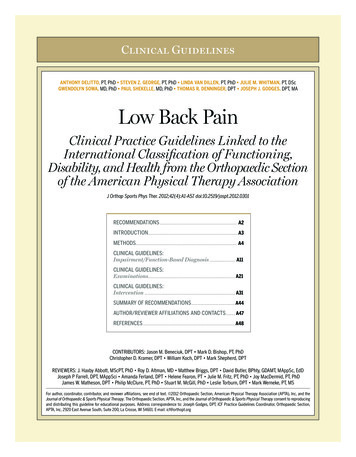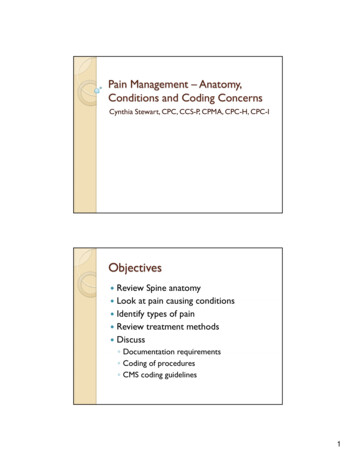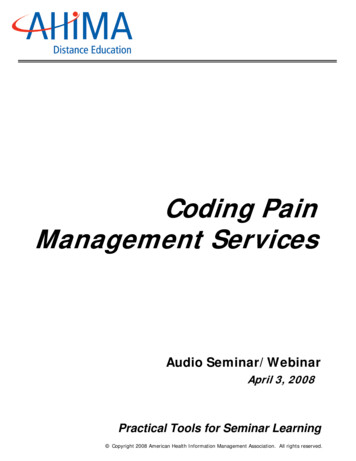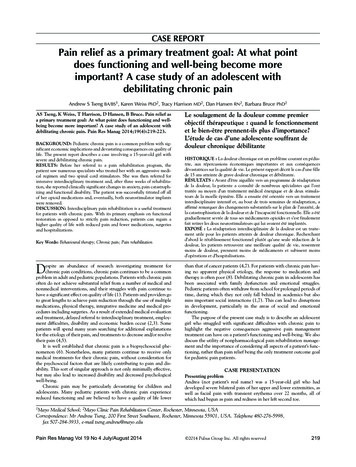
Transcription
case reportPain relief as a primary treatment goal: At what pointdoes functioning and well-being become moreimportant? A case study of an adolescent withdebilitating chronic painAndrew S Tseng BA/BS1, Karen Weiss PhD2, Tracy Harrison MD2, Dan Hansen RN2, Barbara Bruce PhD2AS Tseng, K Weiss, T Harrison, D Hansen, B Bruce. Pain relief asa primary treatment goal: At what point does functioning and wellbeing become more important? A case study of an adolescent withdebilitating chronic pain. Pain Res Manag 2014;19(4):219-223.Background: Pediatric chronic pain is a common problem with significant economic implications and devastating consequences on quality oflife. The present report describes a case involving a 15-year-old girl withsevere and debilitating chronic pain.Results: Before her referral to a pain rehabilitation program, thepatient saw numerous specialists who treated her with an aggressive medical regimen and two spinal cord stimulators. She was then referred forintensive interdisciplinary treatment and, after three weeks of rehabilitation, she reported clinically significant changes in anxiety, pain catastrophizing and functional disability. The patient was successfully titrated off allof her opioid medications and, eventually, both neurostimulator implantswere removed.Discussion: Interdisciplinary pain rehabilitation is a useful treatmentfor patients with chronic pain. With its primary emphasis on functionalrestoration as opposed to strictly pain reduction, patients can regain ahigher quality of life with reduced pain and fewer medications, surgeriesand hospitalizations.Key Words: Behavioural therapy; Chronic pain; Pain rehabilitationDespite an abundance of research investigating treatment forchronic pain conditions, chronic pain continues to be a commonproblem in adult and pediatric populations. Patients with chronic painoften do not achieve substantial relief from a number of medical andnonmedical interventions, and their struggles with pain continue tohave a significant effect on quality of life (1). Patients and providers goto great lengths to achieve pain reduction through the use of multiplemedications, physical therapy, integrative medicine and medical procedures including surgeries. As a result of extended medical evaluationand treatment, delayed referral to interdisciplinary treatment, employment difficulties, disability and economic burden occur (2,3). Somepatients will spend many years searching for additional explanationsfor the etiology of their pain, and treatments to decrease and/or resolvetheir pain (4,5).It is well established that chronic pain is a biopsychosocial phenomenon (6). Nonetheless, many patients continue to receive onlymedical treatments for their chronic pain, without consideration forthe psychosocial factors that are likely contributing to pain and disability. This sort of singular approach is not only minimally effective,but may also lead to increased disability and decreased psychologicalwell-being.Chronic pain may be particularly devastating for children andadolescents. Many pediatric patients with chronic pain experiencereduced functioning and are believed to have a quality of life lowerLe soulagement de la douleur comme premierobjectif thérapeutique : quand le fonctionnementet le bien-être prennent-ils plus d’importance?L’étude de cas d’une adolescente souffrant dedouleur chronique débilitanteHISTORIQUE : La douleur chronique est un problème courant en pédiatrie, aux répercussions économiques importantes et aux conséquencesdévastatrices sur la qualité de vie. Le présent rapport décrit le cas d’une fillede 15 ans atteinte de grave douleur chronique et débilitante.RÉSULTATS : Avant d’être aiguillée vers un programme de réadaptationde la douleur, la patiente a consulté de nombreux spécialistes qui l’onttraitée au moyen d’un traitement médical énergique et de deux stimulateurs de la moelle épinière. Elle a ensuite été orientée vers un traitementinterdisciplinaire intensif et, au bout de trois semaines de réadaptation, aaffirmé remarquer des changements substantiels sur le plan de l’anxiété, dela catastrophisation de la douleur et de l’incapacité fonctionnelle. Elle a étégraduellement sevrée de tous ses médicaments opioïdes et s’est finalementfait retirer les deux neurostimulateurs qui lui avaient été implantés.EXPOSÉ : La réadaptation interdisciplinaire de la douleur est un traitement utile pour les patients atteints de douleur chronique. Recherchantd’abord le rétablissement fonctionnel plutôt qu’une seule réduction de ladouleur, les patients retrouvent une meilleure qualité de vie, ressententmoins de douleur, prennent moins de médicaments et subissent moinsd’opérations et d’hospitalisations.than that of cancer patients (4,7). For patients with chronic pain having no apparent physical etiology, the response to medication andtherapy is often poor (8). Debilitating chronic pain in adolescents hasbeen associated with family dysfunction and emotional struggles.Pediatric patients often withdraw from school for prolonged periods oftime, during which they not only fall behind in academics but alsomiss important social interactions (1,7). This can lead to disruptionsin development, particularly in the areas of social and emotionalfunctioning.The purpose of the present case study is to describe an adolescentgirl who struggled with significant difficulties with chronic pain tohighlight the negative consequences aggressive pain managementtreatment can have on a patient’s functioning and well-being. We alsodiscuss the utility of nonpharmacological pain rehabilitation management and the importance of considering all aspects of a patient’s functioning, rather than pain relief being the only treatment outcome goalfor pediatric pain patients.case presentationPresenting problemAndrea (not patient’s real name) was a 15-year-old girl who haddeveloped severe bilateral pain of her upper and lower extremities, aswell as facial pain with transient erythema over 22 months, all ofwhich had begun as pain and redness in her left second toe.Medical School; 2Mayo Clinic Pain Rehabilitation Center, Rochester, Minnesota, USACorrespondence: Mr Andrew Tseng, 200 First Street Southwest, Rochester, Minnesota 55901, USA. Telephone 480-276-5998,fax 507-284-3933, e-mail tseng.andrew@mayo.edu1MayoPain Res Manag Vol 19 No 4 July/August 2014 2014 Pulsus Group Inc. All rights reserved219
Tseng et alTable 1Medications patient was taking at four time pointsFollow-upAdmissionDischargeZolpidem 12.5 mgonce dailyDuloxetine 60 mgonce dailyDuloxetine 60 mgonce dailyPantoprazole 40mg once dailyPregabalin 150 mgonce dailyTrazadone 50 mgonce dailyTapentadol 100 mgevery 4 hMelatonin 0.5 mgonce dailyThree monthsNoneSix monthsTrazadone 50mg once dailyPantoprazole 40 mgonce dailyMedroxyprogesterone10 mg once dailyTopiramate 25 mgthree times dailyOndansetron 8 mgthree times dailyBaclofen 20 mg twicedailyCephalexin 500 mgfour times dailyFentanyl patch 50 µg/hevery three daysOxycodone 10 mgevery 6 hTemazepam 7.5 mgevery 6 hTrazadone 100 mgtwice dailyCyancobalamininjections 1000 µg/mLevery two weeksDevelopmental and medical historyAndrea grew up in a household with two parents and two youngersiblings (a brother and a sister). Her father worked for the government and her mother worked from home. She described her familysituation as being comfortable and supportive, with no history ofabuse. Before the onset of her pain, Andrea had started public highschool after being home-schooled for four years. She was an honorsstudent who earned mostly As. She was involved in many activities,including piano, flute, guitar and soccer. She believed that she madefriends easily and had a few close confidants who were very supportive of her.Andrea was reportedly healthy until she began noticing rednessand pain in her left second toe while playing soccer at the age of14 years. Within days, she noticed further discolouration and swellingthat worsened over the next three months. At that time, Andrearefused to wear shoes, even in the winter snow, because of this pain.She and her parents sought care at an academic medical centre, wherethe differential diagnoses included Raynaud’s phenomenon, erythromelalgia and reflex sympathetic dystrophy. Additional medical evaluation at other facilities was inconclusive.Through the course of her symptomatology, Andrea had beenevaluated and treated by numerous medical specialists and prescribedmany different pain medications. Although the exact details of timingand dosage medication history were not available for the presentmanuscript, the patient’s mother reported Andrea was first prescribedmethadone, tramadol and gabapentin by a pain specialist who workedin conjunction with a health care provider who practiced ‘holistic220medicine’, which mostly consisted of supplemental vitamins. Whenthose medications were not effective, she tried (in succession) hydromorphone, hydrocodone, oxycodone and oxycontin. When thesemedications did not resolve the pain, she tried tapentadol and pregabalin (combined). Eventually, she added fentanyl patches.In addition to medication management, Andrea also participatedin physical therapy in the form of water aerobics three times per weekand equine therapy as well, both for approximately three months.Despite these treatments, Andrea was unable to find a resolution ofher pain. After approximately 18 months, Andrea also underwentimplantation of a lumbar spinal cord stimulator followed a few monthslater by a cervical spinal cord stimulator. She experienced minimalimprovement in pain, and was subsequently prescribed other medications including multiple opioids to treat her ongoing pain. Her finalmedication regimen when starting the interdisciplinary treatmentprogram is presented in Table 1.During the course of her illness and treatment, Andrea developeddebilitating fatigue and depression with occasional thoughts of suicide.She spoke of losing friends because of her diminished ability to participate in social functions, and had become a victim of bullying due toher symptoms. Furthermore, she had gained 35 pounds (15.75 kg) anddeveloped difficulties with urination and defecation, issues possiblyassociated with her medications and other lifestyle changes (eg,increase in sedentary behaviour). She was only able to pass stools during sleep when her body was sufficiently relaxed, resulting in frequentsoiling of her bed, which her mother would have to clean. As the painprogressed, she became bedridden, and her mother quit her job tobecome her primary home caretaker. Andrea progressively becamemore disabled and eventually was unable to perform basic activities ofdaily living due to her pain. Subsequently, her mother became moreinvolved in caring for these basic needs, including bathing her. Thisregression in autonomy caused some strain on their relationship,which was also distressing to Andrea. Despite the development of significant psychosocial concerns, Andrea was never referred to a psychologist or cognitive behavioural therapist.Initial presentation and behavioural conceptualizationAndrea came to the Mayo Clinic (Rochester, Minnesota, USA) for anadditional opinion for her multiple pain issues as well as urinary anddefecation complaints, multiple food sensitivities and tachycardia. Shesaw providers in neurology, sleep medicine, dermatology, pediatricpain medicine, adolescent psychology and psychiatry, and underwentelectromyography, polysomnography and autonomic reflex screeningwhile at the institution. Numerous physicians became highly concerned with her extensive medication list, particularly given that shewas frequently drowsy during visits with physicians and often fellasleep during interviews.Andrea’s treatment team determined she was struggling with achronic pain condition and given that multiple treatments had notprovided long-term relief and her functioning was severely impaired,she was referred to the Pediatric Pain Rehabilitation Program at theMayo Clinic.Measurement of treatment outcomesAs part of standard clinical practice, Andrea completed several measures before and on discharge from the pain program, in addition tothree and six months following the program. These measures includedfunctional disability because this is the primary treatment goal of thepain program; pain catastrophizing, depression and anxiety because allof these variables can influence pain and disability; and painintensity.Andrea completed the Functional Disability Inventory (FDI) (9),a well-established, 15-item, self-report measure that assesses difficultyin physical and psychosocial functioning due to health status. On thisform, she rated the difficulties in engaging in activities of daily livingwith regard to home, school and social tasks on a five-point scale ranging from 0 (no trouble) to 4 (impossible). FDI scores range betweenPain Res Manag Vol 19 No 4 July/August 2014
Pain relief versus functionality0 and 60, with 0 to 12 none or minimal, 13 to 20 mild, 21 to 29 moderate, and 29 severe functional disability (10). The FDI hasgood reliability, including test-retest reliability (11), and appears to bea valid measure of functional disability in pediatric patients withchronic pain (10,12).Andrea completed the Pain Catastrophizing Scale for Children(13), a 13-item self-report questionnaire that measures exaggeratednegative cognitions about anticipated or actual pain experiences.Responses range from 0 (not at all) to 4 (extremely). Total scores rangefrom 0 to 52 with high scores indicating greater catastrophizing. ThePain Catastrophizing Scale for Children has been shown to be reliableand valid for children and adolescents (13,14).Andrea also completed The Center for Epidemiological StudiesDepression Scale for Children, a self-report measure of depressivesymptoms with acceptable reliability and validity for adolescents (1517). She rated depressive symptoms on a four-point scale ranging from0 (not at all) to 3 (a lot). Total scores range from 0 to 60, with higherscores suggesting more frequent and severe depressive symptoms.General guidelines for interpretation are 16 to 20 mild, 21 to 30 moderate, and 31 severe depressive symptoms.Anxiety was assessed with the Multidimensional Anxiety Scale forChildren (MASC) (18). The MASC is a self-report questionnaire ofanxiety symptoms in children assessing symptoms in four basic scalesincluding physical symptoms, harm avoidance, social anxiety and separation/panic, as well as a total anxiety scale score. The MASC uses T scores(mean 50, SD 10) that are presented according to age and sex.Andrea completed a numerical rating scale to indicate current painintensity on a scale from 0 (indicating ‘no pain’) to 10 (indicating‘worst pain imaginable’). Such rating scales are commonly used toassess pain intensity and have been shown to have good reliability andvalidity in pediatric populations (8,19).ResultsIntensive outpatient pain rehabilitationAndrea and her family participated in a three-week, hospital-basedoutpatient interdisciplinary pediatric pain rehabilitation programaimed at helping adolescents with chronic pain learn coping skills tomanage chronic symptoms to improve functioning. The programincluded physical therapy, occupational therapy, recreational therapy, biofeedback, cognitive behavioural therapy and parent education. The program occurs in a group setting with approximately12 adolescents and young adults between 13 and 21 years of age. Inthis program, there is a significant amount of time dedicated to support and education of parents with 10 h to 15 h of parent programming each week.By the time she had entered the program, Andrea had titrated offsome medications as recommended by her physicians. She was usinga cane to walk and wore sandals that would not exacerbate her footand toe pain. During intake assessments, although oriented to timeand place, Andrea was fatigued and fell asleep multiple times duringconsultation. Her mood was dysphoric and affect was flat. Herthought processes were tangential and content was appropriate tosession. Her speech was slow and slurred. Eye contact was lacking attimes because she had difficulty keeping her eyes open. Andrea andher mother reported being very motivated to decrease medicationsand learn coping skills to manage pain and return to regularfunctioning.Andrea and her treatment team identified major lifestyle functional goals she would work on during treatment: independent performance of daily cares, walking independently, relaxingindependently, eating regular meals, sleeping restfully/wakingindependently, regular school attendance, socialization with peersand medication tapering.Throughout the course of her rehabilitation, Andrea was selfdirected and participated fully in all activities. However, before thestart of medication tapering, Andrea expressed extreme anxiety. Shewas reluctant to stop many of her opioid medications for fear of painPain Res Manag Vol 19 No 4 July/August 2014Figure 1) Outcome variables at four time pointsexacerbation. She cried throughout consultations and was in clearemotional distress. However, she was gradually able to taper off allopioid medications including tapentadol, fentanyl patch and oxycodone, as well as sleep medications.Her mental status gradually improved and she was more fully ableto participate in daily programming and interactions with her peers.She worked at decreasing pain behaviours and cooperated with thetreatment team. Within one week, she was able to walk without hercane. Initially, she had extreme difficulty with compliance with wearing socks and shoes due to allodynia. However, by the second week oftherapy, she was able to wear shoes full time, in part as a result of theintensive physical therapy and desensitization that occurred on a dailybasis as part of programming.Andrea was asked to turn off her spinal cord stimulators for shortperiods of time and to use the coping strategies she was learning tomanage any symptoms. Andrea complied, but experienced increasedanxiety while doing so and was not able to discontinue use of theneurostimulators while in the three-week program. Nonetheless, shemade drastic improvements in all five major lifestyle goals, and onceagain was able to function independently. She was encouraged to consider weaning off the neurostimulators at some point in the futurewhen she believed her coping skills were more solidified.In the parent program, Andrea’s mother learned strategies to besupportive of her daughter while encouraging developmentally appropriate autonomy. She was asked to ignore pain behaviours and discontinue talking about symptoms with her daughter. She also developed abehaviour plan to provide incentives for progress and decreased privileges when Andrea demonstrated inappropriate behaviours such asbeing disrespectful toward parents, or missing school or other activities. Andrea’s mother reported this aspect of the program was veryhelpful and she felt confident that she could return home and implement these strategies.At the end of the program, Andrea reported clinically significantdecreases in pain catastrophizing, anxiety and functional disability(Figure 1). At the six-month follow-up, she reported an absence ofpain, pain catastrophizing and functional disability. Depression andanxiety symptoms were in the nonclinical range (Figure 1). She wasalso successfully titrated off all of her narcotic medications and most ofher sleep medications by discharge and by three- and six-monthfollow-up (Table 1).One-year follow-upOne year later, Andrea’s mother telephoned the program staff to reportthat Andrea had continued to do well once returning home from thePediatric Pain Rehabilitation Program. Andrea was attending schoolfull time and was involved in a variety of extracurricular activities,221
Tseng et alincluding volleyball. She had returned to her normal weight.Eventually, Andrea decided the neurostimulators bothered her anddecided to have them both removed, despite some hesitation from hermedical providers at home due to concerns about relapse. Her motherreported that Andrea returned to her baseline level of functioningbefore pain onset and was now able to perform all of her activities ofdaily living.DiscussionThe present case illustrates the devastating effects of chronic pain andhow aggressive medical treatments may not provide adequate painrelief and may actually contribute to increased disability. The nature ofAndrea’s symptoms and her parents’ desires to help their child led tointensive evaluation by multiple physicians to rule out the possibilityof life-threatening disorders. When a specific diagnosis was eventuallysuggested, she attempted numerous medications and implantation oftwo spinal cord stimulators. Most importantly, her functioning andwell-being did not improve but continued to decline with persistentpain, depression and the side effects of multiple drugs. Regardless ofetiology, Andrea’s pain developed into a chronic pain syndrome thatinvolved severe disability. An interdisciplinary approach that includeddecreasing medications, physical reconditioning, and cognitive andbehavioural therapy proved to be highly effective in decreasing anxiety, depression and disability for this patient.The search for a definitive diagnosis in the setting of chronic painThe present case highlights the inherent difficulties of treatingpatients with chronic pain. Patients with chronic pain may feel frustrated and hopeless without a definitive diagnosis, and this may fuelfurther preoccupation with their pain. Patients often feel dissatisfiedand/or invalidated when informed that multiple tests have notrevealed a cause for their pain. They may then feel misunderstood andcontinue to search relentlessly for an answer and satisfactory treatment(20). They often believe providers are suggesting that their pain is ‘notreal’ or is psychological in nature. In addition, because of the physicaldisability and depression that are often comorbid with chronic pain,patients and caretakers may often be even more desperate for ananswer to resolve these issues. Thus, one of the greatest dangers occurswhen desperate patients are driven to pursue drastic therapies inattempts to eliminate their pain.For Andrea’s parents, their well-intentioned concerns and their desireto find a cure for their daughter’s pain led them on a time-consumingjourney through doctors’ offices and operating rooms. In their situation, it may have been reasonable to seek a second opinion, especiallywhen the diagnosis was inconclusive and their daughter continued toexperience significant pain. Their persistence may appear to have paidoff when well-meaning physicians prescribed a new intervention thatmay have worked temporarily, only to relapse back into the cycle ofcontinued pain and poor functioning. When one therapy did notwork, they sought yet another treatment from another provider. In theend, these aggressive and experimental treatments accumulated andproved to be deleterious.Pain reduction versus functioning and well-beingMany health care providers may define success in pain managementas a reduction in pain score. Although this is certainly an appropriatetarget in the treatment of acute pain, targets for the treatment ofchronic pain should also include improvement in functioning andoverall well-being because complete pain relief may not be an attainable goal. More importantly, consuming preoccupation with painrelief may lead to years of searching for the next best treatment andavoidance of regular activities. Unfortunately, patients who decide tobe home-schooled and stop activities that exacerbate their painoften experience increased pain and worsened functioning (7).In the case of Andrea, it was likely the combination of her distress about her pain, her parents’ concern about her well-being andher health care providers’ desire to help her feel better that led to222multiple medications that impacted her ability to function from acognitive standpoint. The continued progression of her disabilitythen led to unhealthy changes in the family dynamic, difficultyattending school, decreased participation in preferred activities andeventual isolation from same-age peers. All of this then contributedto Andrea struggling with self-esteem issues (self-efficacy aboutbeing able to perform most normal daily tasks), depression and suicidal ideation. By focusing primarily on the treatment of her pain,her health care providers may not have realized the negative effectsthis treatment was having on her overall functioning. Her treatmentcourse appeared to have contributed to the transformation of ahealthy and active 15-year-old girl into a minimally responsive,depressed and dysfunctional patient.Cognitive behavioural therapy, interdisciplinary approaches, andfunctional restorationCognitive behavioural therapy and interdisciplinary approaches arethe most widely accepted biopsychosocial treatments for chronic pain(21,22). These treatments often do not focus on elimination of painbut on functional restoration (23). When compared with opioid andother medical treatments, cognitive behavioural therapy and interdisciplinary approaches not only yield comparable pain reductionrates, but are also more cost-effective and lead to significant increasesin physical functionality, and reductions in future hospitalizations andsurgeries (22,24-27). In the pediatric population, it is particularlyimportant to minimize this disruption in development by allowingchildren to return to school and to hopefully begin the process of normalizing their lives (28).Given the utility of the biopsychosocial conceptualization andapproach to chronic pain, we recommend health care providers consider interdisciplinary screening at initial assessment for all providerswith chronic pain. In addition, at any point in the treatment ofchronic pain where functioning starts to be adversely affected, aninterdisciplinary treatment would likely be helpful. Moreover, patientstend to be more accepting of such an approach when providers emphasize that reported symptoms are real, but chronic pain has a complexetiology that requires treatment of the problem(s) from multipleangles.Andrea’s story highlights the importance of consideration of allaspects of a patient’s well-being, including involvement in typicalactivities (eg, school), social interaction, family relationships andpsychological well-being. Attempts at pain reduction should not bemade without considering the possible effects on these other areas offunctioning. Notably, in Andrea’s case, we observed an improvementin functioning before an improvement in pain intensity. It is alsoimportant to note that an improvement in functioning without anyimprovement in pain intensity would have still been considered atreatment success.ConclusionAlthough Andrea’s case is an extreme example, her experiences ofspending years seeking a satisfactory medical diagnosis and treatmentto eliminate pain, and progressive disability in multiple areas of functioning mirror that of many adolescents who experience chronicpain. Fortunately, Andrea was ultimately referred to an interdisciplinary treatment program that encouraged her to discontinue medications causing side effects and helped her and her family learn andimplement strategies of increased coping in the context of pain andreconceptualizing the treatment goal to be fullly functioning. For themillions of individuals experiencing chronic pain, it is imperative tohave discussions about comprehensive approaches to pain management and the importance of including quality of life and overallfunctioning as treatment goals, which are just as important, if notmore so, as alleviating the pain itself.Disclosures: None.Pain Res Manag Vol 19 No 4 July/August 2014
Pain relief versus functionalityReferences1. van Tilburg MA, Spence NJ, Whitehead WE, Bangdiwala S,Goldston DB. Chronic pain in adolescents is associated withsuicidal thoughts and behaviors. J Pain 2011;12:1032-9.2. Gaskin DJ, Richard P. The economic costs of pain in the UnitedStates. J Pain 2012;13:715-24.3. Sleed M, Eccleston C, Beecham J, Knapp M, Jordan A. The economicimpact of chronic pain in adolescence: Methodological considerationsand a preliminary costs-of-illness study. Pain 2005;119:183-90.4. Eccleston C, Malleson P. Managing chronic pain in children andadolescents. We need to address the embarrassing lack of data forthis common problem. BMJ 2003;326:1408-9.5. Lachapelle DL, Lavoie S, Boudreau A. The meaning and process ofpain acceptance. Perceptions of women living with arthritis andfibromyalgia. Pain Res Manag 2008;13:201-10.6. Gatchel RJ, Peng YB, Peters ML, Fuchs PN, Turk DC.The biopsychosocial approach to chronic pain: Scientific advancesand future directions. Psychol Bull 2007;133:581-624.7. Zernikow B, Wager J, Hechler T, et al. Characteristics of highlyimpaired children with severe chronic pain: A 5-year retrospectivestudy on 2249 pediatric pain patients. BMC Pediatr 2012;12:54.8. Miro J, Castarlenas E, Huguet A. Evidence for the use of anumerical rating scale to assess the intensity of pediatric pain.Eur J Pain 2009;13:1089-95.9. Walker LS, Greene JW. The functional disability inventory:Measuring a neglected dimension of child health status.J Pediatr Psychol 1991;16:39-58.10. Kashikar-Zuck S, Flowers SR, Claar RL, et al. Clinical utility andvalidity of the Functional Disability Inventory among a multicentersample of youth with chronic pain. Pain 2011;152:1600-7.11. Claar RL, Walker LS. Functional assessment of pediatric painpatients: Psychometric properties of the functional disabilityinventory. Pain 2006;121:77-84.12. Gauntlett-Gilbert J, Eccleston C. Disability in adolescents withchronic pain: Patterns and predictors across different domains offunctioning. Pain 2007;131:132-141.13. Crombez G, Bijttebier P, Eccleston C, et al. The child version of thePain Catastrophizing Scale (PCS-C): A preliminary validatio
1Mayo Medical School; 2Mayo Clinic Pain Rehabilitation Center, Rochester, Minnesota, USA Correspondence: Mr Andrew Tseng, 200 First Street Southwest, Rochester, Minnesota 55901, USA. Telephone 480-276-5998, fax 507-284-3933, e-mail tseng.andrew@mayo.edu D espite an abundance of research investigating treatment for



